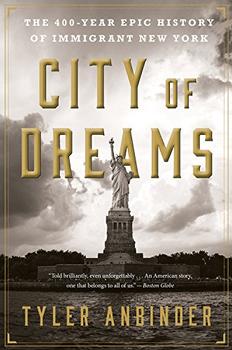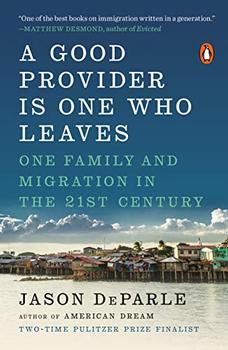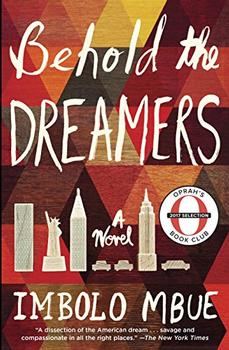Summary | Excerpt | Reviews | Beyond the book | Read-Alikes | Genres & Themes | Author Bio

The 400-Year Epic History of Immigrant New York
by Tyler AnbinderPerhaps there are books about the immigrant experience in America that are longer than Tyler Anbinder's City of Dreams (768 pages), and conceivably cover even more years (1632 to the present) than this one, but I'd be surprised if any other related volume offers more "I never realized that" moments. Here are just a handful:
It would take a ridiculous number of pages to chronicle all such fascinating revelations embedded within Anbinder's brick of a book, a sprawling chronicle which lives up to its subtitle: The 400-Year Epic History of Immigrant New York. For all its comprehensiveness, it remains a compelling – and at times touchingly personal – page-turner. In an author's note, Anbinder explains that The City of Dreams focuses more heavily on the distant past than on contemporary New York because, for recent immigrants, "few of their scrapbooks, diaries, and photos have made their way from their grandchildren's attics to archives and historical societies. Social scientists are studying today's immigrants, but their data-heavy, theoretically oriented publications lack the compelling personal narratives that make New York's immigration history so rich and rewarding."
City of Dreams tells much of its capacious, centuries-long story through the eyes of individual immigrants from Holland, England, Ireland, Italy, Germany, Eastern Europe, Puerto Rico and the Caribbean. William R. Grace's life typifies the "rags-to-riches" American dream. He fled the Irish potato famine in 1846 and came to New York City, finding work in a print shop and as a cobbler's helper. Grace, who had savvy business instincts, became involved in the shipping industry and eventually launched a very successful trading company handling construction, sugar, rubber, and cotton interests in the Caribbean and South America. Though he had no experience in politics, he was recruited to run for mayor (and won) in 1880, despite a strong campaign of anti-Catholic prejudice mounted by his opponents.
Anbinder uses diaries, letters, and family history, as well as more public discourses like newspapers and government proclamations to piece together a narrative of perpetual arrival and assimilation, a human ebb and flow mirroring the tidal pull of New York harbor that has made the city the world's most celebrated melting pot.
But Anbinder also embraces "big picture" history. For example, his chapter on the potato famine of the nineteenth century is superb and wide-ranging, focusing as few other histories do on its impact on all of Europe rather than just Ireland, the epicenter of the blight. Equally impressive are discussions of the twentieth century labor movement, the horrors of tenement housing, the rise of the nativist "Know Nothing" party, and the tensions between German immigrants and the rest of the NYC population just before and during World War I.*
Many prominent figures from U.S. history and culture get their due in this book. Henry Hudson, Ben Franklin, John Peter Zenger, Emma Lazarus, Joseph Pulitzer, Samuel Gompers, Emma Goldman, and even Oscar de la Renta – many of them immigrants who made New York their new home – command large chunks of the narrative.
Reading City of Dreams makes one aware that New York City, despite its founding four centuries ago, has never really been "settled." It is always being reinvented and reinvigorated – though often with a good deal of friction. As Anbinder notes when discussing pockets of anti-Muslim sentiment in the city since 9/11, "The story of New York's immigrants shows that yesterday's un-American religion is today's mainstream one. In the seventeenth century, Lutherans, Quakers, and Huguenots were considered radicals and a threat to the safety of the city. Before long, those groups were welcome and Catholics were considered a menace. Then radical Jews and Italians. And now radical Muslims."
And so it goes, over and over, one wave of new immigrants' settlement nightmares becoming the American dream of successive generations. In a 1909 article about the perpetual renewal of New York City, Life magazine's editors noted, "No man will ever see its finish." Fortunately, we have in City of Dreams, a fascinating and detailed record of all that has come before.
*Germany's secret plan to forge an alliance with Mexico should the U.S. enter the war enraged American public opinion when it was discovered, and the declaration of war against Germany in 1917 caused some New Yorkers to view the German immigrant community with suspicion. There doesn't seem to have been nearly the same level of disdain for Germans during the Second World War, perhaps because by then the German Community had been established for more than half a century, and most male German Americans of fighting age, like every other immigrant group, enlisted in large numbers. There also seems to have been some widespread sympathy for Germans fleeing Nazi Germany.
![]() This review was originally published in The BookBrowse Review in November 2016, and has been updated for the
October 2017 edition.
Click here to go to this issue.
This review was originally published in The BookBrowse Review in November 2016, and has been updated for the
October 2017 edition.
Click here to go to this issue.

If you liked City of Dreams, try these:

A Good Provider Is One Who Leaves
by Jason DeParle
Published 2020
The definitive chronicle of our new age of global migration, told through the multi-generational saga of a Filipino family, by a veteran New York Times reporter and two-time Pulitzer Prize finalist.

by Imbolo Mbue
Published 2017
Oprah Winfrey's Summer 2017 Book Club Pick
In the vein of Amy Tan and Khaled Hosseini comes a compulsively readable debut novel about marriage, immigration, class, race, and the trapdoors in the American Dream - the unforgettable story of a young Cameroonian couple making a new life in New York just as the Great Recession upends the economy.






Your guide toexceptional books
BookBrowse seeks out and recommends the best in contemporary fiction and nonfiction—books that not only engage and entertain but also deepen our understanding of ourselves and the world around us.